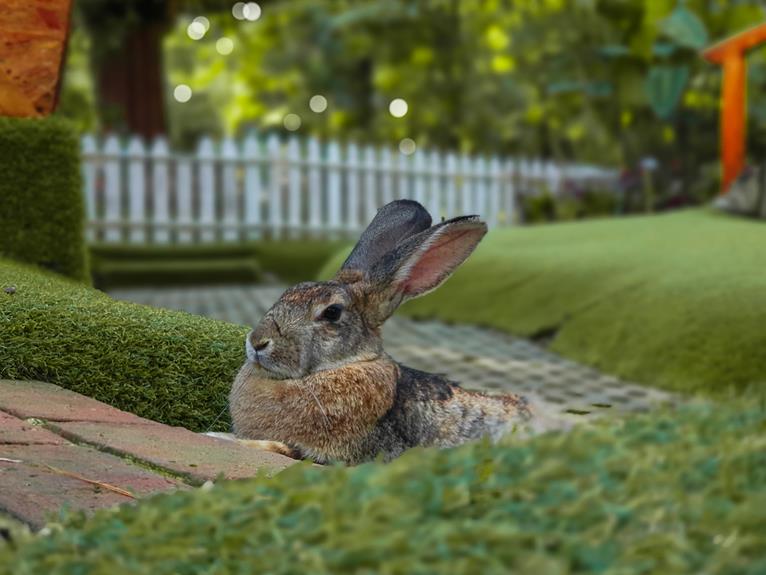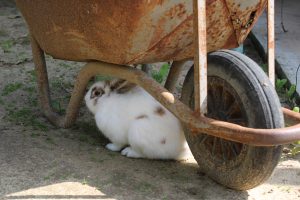Are you tired of hopping through your yard, avoiding those pesky rabbit droppings? Well, fear not! We’ve got the scoop on how to remove rabbit poop from your yard in no time.
With a few simple steps and the right tools, you can have your outdoor space looking clean and tidy once again. Say goodbye to those unwanted surprises and hello to a poop-free paradise.
Let’s get started on reclaiming your yard from those furry little visitors!
In This Article
- 1 Key Takeaways
- 2 Understanding Rabbit Poop: Differentiating Between Rabbit Droppings and Other Animal Waste
- 3 Gathering the Necessary Tools: Equip Yourself With the Right Supplies for Efficient Cleanup
- 4 Preparing the Yard: Clearing the Area and Taking Necessary Precautions Before Removing Rabbit Poop
- 5 Effective Cleaning Techniques: Step-By-Step Instructions on How to Remove Rabbit Poop From Your Yard
- 6 Preventing Future Infestations: Tips and Tricks to Discourage Rabbits From Leaving Their Droppings in Your Yard
- 7 Frequently Asked Questions
- 7.1 How Can I Tell the Difference Between Rabbit Droppings and Other Animal Waste?
- 7.2 What Tools Do I Need to Effectively Clean up Rabbit Poop From My Yard?
- 7.3 Are There Any Precautions I Should Take Before Removing Rabbit Poop From My Yard?
- 7.4 Can You Provide a Step-By-Step Guide on How to Clean up Rabbit Poop From My Yard?
- 7.5 What Are Some Tips and Tricks to Prevent Rabbits From Leaving Their Droppings in My Yard in the Future?
- 8 Conclusion
Key Takeaways
- Rabbit droppings are small, round pellets with a dark brown or black color, often found in clusters and with a uniform shape.
- Gathering the necessary tools such as a rake and a trash bag, as well as wearing protective gear like gloves and a mask, is important when removing rabbit poop from the yard.
- Preparing the yard involves clearing the area around the rabbit poop, removing excess debris or vegetation, and washing hands thoroughly after waste removal.
- Effective cleaning techniques include gathering droppings using a rake or scoop, using gloves, a bucket, and a hose for cleaning, disposing of the droppings properly, using a natural deterrent, and restoring the yard to its former state.
Understanding Rabbit Poop: Differentiating Between Rabbit Droppings and Other Animal Waste
You should carefully observe the poop in your yard to accurately determine if it’s rabbit droppings or another animal’s waste. Differentiating between rabbit droppings and other animal waste is crucial for effective yard maintenance.
Rabbit droppings are typically small, round pellets, similar in size to a pea. They’re uniform in shape and have a dark brown or black color. Additionally, rabbit droppings are often found in clusters, as rabbits tend to defecate in the same area repeatedly.
Understanding rabbit feeding habits can also help in identifying their droppings. Rabbits are herbivores and their diet consists mainly of grass, leaves, and other plant materials. As a result, their droppings are rich in fiber and have a mild odor.
Gathering the Necessary Tools: Equip Yourself With the Right Supplies for Efficient Cleanup
To efficiently clean up the rabbit poop in your yard, gather a rake and a trash bag. These simple cleaning supplies will make the task easier and more effective.
Start by putting on some protective gear, such as gloves and a mask, to keep yourself safe from any potential bacteria or parasites in the droppings.
Once you’re equipped, use the rake to gently gather the rabbit poop into a pile. Be careful not to press too hard or damage your lawn in the process.
Once you’ve gathered the droppings, carefully scoop them into the trash bag, making sure to seal it tightly afterward. Dispose of the bag in an appropriate manner, such as in your regular trash or by composting them if you have a compost bin.
Remember to wash your hands thoroughly after handling the droppings.
Preparing the Yard: Clearing the Area and Taking Necessary Precautions Before Removing Rabbit Poop
Make sure you clear the area around the rabbit poop and take necessary precautions before removing it from your yard.
Yard preparation is essential to ensure a safe and efficient cleanup process. Start by wearing gloves and protective clothing to protect yourself from any potential pathogens that may be present in the feces.
Use a rake or scoop to gather the droppings, making sure to remove any excess debris or vegetation around them. It’s important to dispose of the rabbit poop in a designated waste bag or container to prevent contamination.
After removing the waste, consider washing your hands thoroughly with soap and water to maintain hygiene.
Effective Cleaning Techniques: Step-By-Step Instructions on How to Remove Rabbit Poop From Your Yard
Start by gathering 10 to 15 droppings using a rake or scoop, ensuring you remove them from your yard effectively.
Rabbit poop can be a nuisance, but with the right cleaning techniques, you can restore your yard to its former glory.
To begin, gather the necessary cleaning supplies such as gloves, a bucket, and a hose. Put on your gloves to protect your hands from any bacteria or parasites that may be present.
Use the rake or scoop to carefully collect the droppings, placing them in the bucket. Make sure to dispose of them properly.
Once the droppings are removed, use a natural deterrent, such as crushed red pepper or vinegar, to prevent rabbits from returning to your yard.
Preventing Future Infestations: Tips and Tricks to Discourage Rabbits From Leaving Their Droppings in Your Yard
Use mesh fencing around your garden to create a physical barrier and discourage rabbits from leaving their droppings in your yard. This simple yet effective method can prevent future infestations and keep your yard clean. In addition to fencing, there are also natural deterrents that can help discourage rabbits from entering your property. Consider planting strong-smelling herbs like lavender, rosemary, or mint around your garden. These scents are known to repel rabbits and can help protect your plants. Another option is to use homemade sprays made from garlic, onion, or hot pepper. Rabbits dislike the strong odors and taste, making them less likely to linger in your yard. By implementing these preventative measures, you can create a rabbit-free zone in your yard and enjoy a clean and poop-free outdoor space.
| Natural Deterrents | Benefits |
|---|---|
| Strong-smelling herbs | Repel rabbits |
| Homemade sprays | Dislike odors and taste |
| Mesh fencing | Physical barrier |
| Clean and poop-free yard | Enjoy outdoor space |
| Prevent future infestations | Protect your plants |
Frequently Asked Questions
How Can I Tell the Difference Between Rabbit Droppings and Other Animal Waste?
To identify rabbit droppings and manage rabbit waste, look for small, round pellets that are dark in color and have a dry texture. Once identified, you can remove them from your yard using various methods.
What Tools Do I Need to Effectively Clean up Rabbit Poop From My Yard?
To effectively clean up rabbit poop from your yard, you’ll need a few simple tools. A sturdy rake and a pair of gloves will help you gather the droppings, while a shovel and a trash bag will make for safe disposal.
Are There Any Precautions I Should Take Before Removing Rabbit Poop From My Yard?
Before removing rabbit poop from your yard, it’s important to take precautions and follow safety measures. This includes wearing gloves, using a shovel or scoop, and properly disposing of the waste to prevent any potential health risks.
Can You Provide a Step-By-Step Guide on How to Clean up Rabbit Poop From My Yard?
To effectively clean up rabbit poop from your yard, follow these steps: 1) Use gloves and a shovel to collect the droppings. 2) Dispose of them in a compost bin for the best method of composting. 3) Protect your garden by fencing it off from rabbit damage.
What Are Some Tips and Tricks to Prevent Rabbits From Leaving Their Droppings in My Yard in the Future?
To prevent rabbits from leaving droppings in your yard, start by creating a rabbit proof fence. Use natural remedies like planting strong-smelling herbs or placing predator decoys. These tips will help keep your yard poop-free and rabbit-free.
Conclusion
In the battle against rabbit poop in your yard, knowledge is your greatest weapon. By understanding the difference between rabbit droppings and other animal waste, equipping yourself with the right tools, and following effective cleaning techniques, you can reclaim your outdoor space.
Remember, prevention is key, so use these tips and tricks to discourage rabbits from leaving their droppings behind. With a little effort and know-how, you can create a poop-free paradise in your yard.





